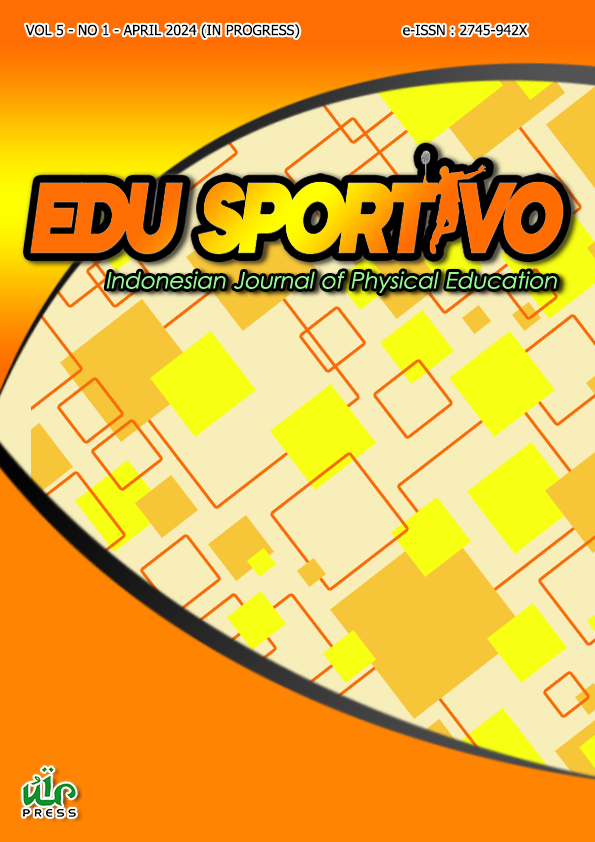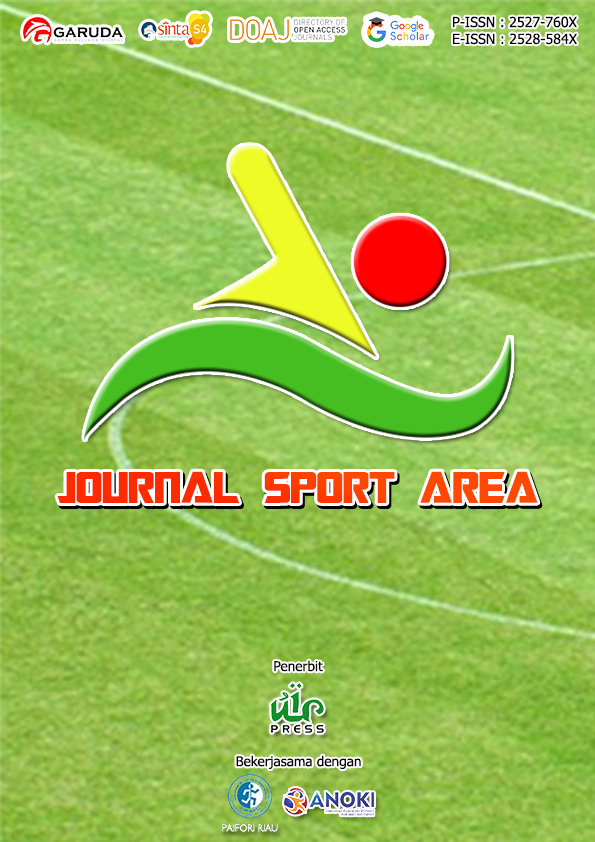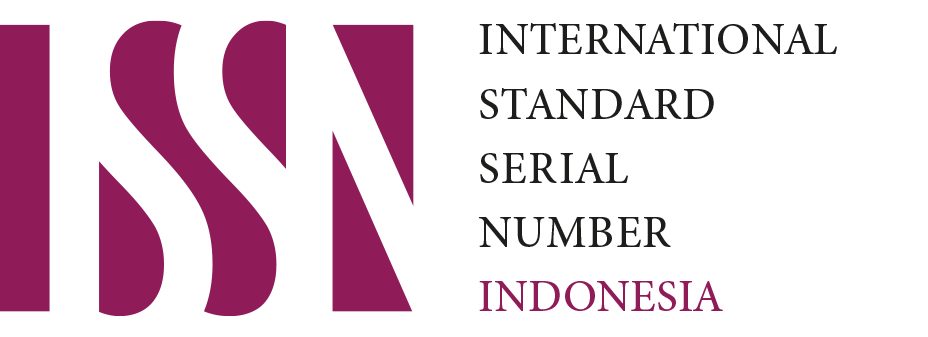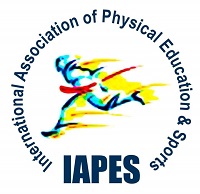Emerging trends in physical education and inclusive education: A scientometric analysis
Keywords:
Inclusive education, physical education, scientometricAbstract
Background Problems: In recent years, there has been a growing recognition of the importance of inclusive education and physical education in promoting equality, diversity, and overall well-being among students. However, there is a need for a comprehensive understanding of the scholarly landscape and emerging trends in this field. Research Objectives: The aim of this study is to develop a scientometric analysis of scientific production on inclusive education and physical education. Methods: The databases used in this study were acquired from the Web of Science (WoS) and SCOPUS, with the most recent update occurring in 2021. The bibliographic datasets were pre-processed using ScientoPy and VOSviewer. Findings/Results: The results showed that: (i) The trend of publications related to inclusive and physical education has reached 438 papers since its first publication in 1968. Additionally, it is demonstrated that the distribution of papers increases progressively over time. (ii) Justin A. Haegele of Old Dominion University, Norfolk, United States, has become the most contributing and influential writer in the field of inclusive education and physical education, with 11 papers and 192 citations; Of the 10 journals identified, Physical Education and Sport Pedagogy was the journal that contributed the most with 33 papers; the most influential top paper with 172 citations was entitled “Inclusive physical education from the perspective of students with physical disabilities." The most frequently used keywords were “physical education," "inclusion,” and “inclusive education." Conclusion: The scientometric analysis revealed a wealth of research on inclusive and physical education for students with disabilities, thereby broadening the scope of adaptive physical education. By emphasising the role of inclusive education in promoting equality, diversity, and overall well-being among students, this research contributes to the ongoing discourse on the establishment of inclusive environments in educational settings.
Downloads
References
Abramo, G. (2018). Revisiting the Scientometric Conceptualisation of Impact and its Measurement. Journal of Informetrics, 12(3), 590–597. https://doi.org/10.1016/j.joi.2018.05.001
Bejerot, S., & Humble, M. (2007). Relevance of Motor Skill Problems in Victims of Bullying. Pediatrics, 120(5), 1225–1226. https://doi.org/10.1542/peds.2007-2187
Braksiek, M. (2022). Pre-Service Physical Education Teachers’ Attitudes Toward Inclusive Physical Education Subject Specificity and Measurement Invariance. German Journal of Exercise and Sport Research, 52, 1–10. https://doi.org/10.1007/s12662-021-00755-1
Bredahl, A. M. (2013). Sitting and Watching the Others Being Active: the Experienced Difficulties in PE when Having a Disability. Adapted Physical Activity Quarterly, 30(1), 40–58. https://doi.org/10.1123/apaq.30.1.40
Coates, J. K. (2012). Teaching Inclusively: are Secondary Physical Education Student Teachers Sufficiently Prepared to Teach in Inclusive Environments? Physical Education and Sport Pedagogy, 17(4), 349–365. https://doi.org/10.1080/17408989.2011.582487
European Agency for Development in Special Needs Education. (2012). Profile of Inclusive Teachers. In European Journal of Special Needs Education (Vol. 12, Issue 1).
Fitzgerald, H. (2012). “Drawing” on Disabled Students’ Experiences of Physical Education and Stakeholder Responses. Sport, Education and Society, 17(4), 443–462. https://doi.org/10.1080/13573322.2011.609290
Fitzpatrick, K. (2013). Critical Pedagogy, Physical Education and Urban Schooling. Counterpoints: Studies in the Postmodern Theory of Education. Peter Lang.
Flecha, R. (2015). Successful Educational Actions for Inclusion and Social Cohesion in Europe. Springer International Publishing. https://doi.org/10.1007/978-3-319-11176-6
Forlin, C. (2013). Changing Paradigms and Future Directions for Implementing Inclusive Education in Developing Countries. Asian Journal of Inclusive Education, 2(1), 19–31. https://doi.org/10.59595/ajie.01.2.3
Fuller, B., Gulbrandson, K., & Herman-Ukasick, B. (2013). Bully Prevention in the Physical Education Classroom. Strategies: A Journal for Physical and Sport Educators, 26(6), 3–8. https://doi.org/10.1080/08924562.2013.839425
Garfield, E. (2009). From the Science of Science to Scientometrics Visualising the History of Science with Histcite Software. Journal of Informetrics, 3(3), 173–179. https://doi.org/10.1016/j.joi.2009.03.009
Gill, D. L., Morrow, R. G., Collins, K. E., Lucey, A. B., & Schultz, A. M. (2010). Perceived Climate in Physical Activity Settings. Journal of Homosexuality, 57(7), 895–913. https://doi.org/10.1080/00918369.2010.493431
Goodwin, D. L., & Watkinson, E. J. (2000). Inclusive Physical Education from the Perspective of Students with Physical Disabilities. Adapted Physical Activity Quarterly, 17(2), 144–160. https://doi.org/10.1123/apaq.17.2.144
Grenier, M., Collins, K., Wright, S., & Kearns, C. (2014). Perceptions of a Disability Sport Unit in General Physical Education. Adapted Physical Activity Quarterly, 31(1), 49–66. https://doi.org/10.1123/apaq.2013-0006
Griggs, G., & Medcalf, R. (2015). Inclusive Pedagogy Across the Curriculum. International Perspectives on Inclusive Education, 7, 11–24. https://doi.org/10.1108/s1479-363620150000007006
Grimminger, E. (2014). Getting Into Teamsin Physical Education and Exclusion Processes among Students. Pedagogies, 9(2), 155–171. https://doi.org/10.1080/1554480X.2014.899546
Haegele, J. A., & Sutherland, S. (2015). Perspectives of Students with Disabilities Toward Physical Education: A Qualitative Inquiry Review. Quest, 67(3), 255–273. https://doi.org/10.1080/00336297.2015.1050118
Hansen, J. H. (2012). Limits to inclusion. International Journal of Inclusive Education, 16(1), 89–98. https://doi.org/10.1080/13603111003671632
Healy, S., Msetfi, R., & Gallagher, S. (2013). “Happy and a Bit Nervous”: The Experiences of Children with Autism in Physical Education. British Journal of Learning Disabilities, 41(3), 222–228. https://doi.org/10.1111/bld.12053
Healy, S. (2014). Preventing Bullying in Inclusive Physical Education: Practical Strategies for Teachers. Palaestra, 28(2), 42–47. https://link.gale.com/apps/doc/A392570679/AONE?
Hodge, S., Lieberman, L., & Murata, N. (2012). Essentials of Teaching Adapted Physical Education: Diversity, culture, and inclusion. Routledge. https://doi.org/10.4324/9781351217385
Hutzler, Y., Meier, S., Reuker, S., & Zitomer, M. (2019). Attitudes and Self-Efficacy of Physical Education Teachers Toward Inclusion of Children with Disabilities: a Narrative Review of International Literature. Physical Education and Sport Pedagogy, 24(3), 249–266. https://doi.org/10.1080/17408989.2019.1571183
Li, H., Li, W., Zhao, Q., & Li, M. (2017). Including Overweight and Obese Students in Physical Education: An Urgent Need and Effective Teaching Strategies. Journal of Physical Education, Recreation & Dance, 88(5), 33–38. https://doi.org/10.1080/07303084.2017.1294513
Mangope, B., Mannathoko, M. C., & Kuyini, A. B. (2013). Pre-Service Physical Education Teachers and Inclusive Education: Attitudes, Concerns and Perceived Skill Needs. International Journal of Special Education, 28(3), 82–92.
McLennan, N. (2018). Quality Physical Education: Policies, Guidelines, Methodology. UNESCO.
Messiou, K., Ainscow, M., Echeita, G., Goldrick, S., Hope, M., Paes, I., Sandoval, M., Simon, C., & Vitorino, T. (2016). Learning from Differences: a Strategy for tacher Development in Respect to Student Diversity. School Effectiveness and School Improvement, 27(1), 45–61. https://doi.org/10.1080/09243453.2014.966726
Mingers, J., & Leydesdorff, L. (2015). A Review of Theory and Practice in Scientometrics. European Journal of Operational Research, 246(1), 1–19. https://doi.org/10.1016/j.ejor.2015.04.002
Moriña, A. (2017). Inclusive Education in Higher Education: Challenges and Opportunities. European Journal of Special Needs Education, 32(1), 3–17. https://doi.org/10.1080/08856257.2016.1254964
Nilholm, C., & Göransson, K. (2017). What is Meant by Inclusion? an Analysis of European and North American Journal Articles with High Impact. European Journal of Special Needs Education, 32(3), 437–451. https://doi.org/10.1080/08856257.2017.1295638
O’Brien, D., Kudláček, M., & Howe, P. D. (2009). a Contemporary Review of English Language Literature on Inclusion of Students With Disabilities in Physical Education: a European Perspective. European Journal of Adapted Physical Activity, 2(1), 46–61. https://doi.org/10.5507/euj.2009.004
Penney, D., Jeanes, R., O’Connor, J., & Alfrey, L. (2018). Re-Theorising Inclusion and Reframing Inclusive Practice in Physical Education. International Journal of Inclusive Education, 22(10), 1062–1077. https://doi.org/10.1080/13603116.2017.1414888
Pérez-Gutiérrez, M., Castanedo-Alonso, J. M., Salceda-Mesa, M., & Cobo-Corrales, C. (2021). Scientific Production on Inclusive Education and Physical Education: a Bibliometric Analysis. International Journal of Inclusive Education, 0(0), 1–17. https://doi.org/10.1080/13603116.2021.1916103
Pocock, T., & Miyahara, M. (2018). Inclusion of Students with Disability in Physical Education: a Qualitative Meta-Analysis. International Journal of Inclusive Education, 22(7), 751–766. https://doi.org/10.1080/13603116.2017.1412508
Portelli, J. P., & Koneeny, P. (2018). Inclusive Education: Beyond Popular Discourses. International Journal of Emotional Education, 10(1), 133–144.
Qi, J., & Ha, A. S. C. (2012). Hong Kong Physical Education Teachers’ Beliefs about Teaching Students with Disabilities: a Qualitative Analysis. Asian Social Science, 8(8), 3–14. https://doi.org/10.5539/ass.v8n8p3
Ramy, A., Floody, J., Ragab, M. A. F., & Arisha, A. (2018). A Scientometric Analysis of Knowledge Management Research and Practice Literature: 2003-2015. Knowledge Management Research and Practice, 16(1), 66–77. https://doi.org/10.1080/14778238.2017.1405776
Rekaa, H., Hanisch, H., & Ytterhus, B. (2019). Inclusion in Physical Education: Teacher Attitudes and Student Experiences. A Systematic Review. International Journal of Disability, Development and Education, 66(1), 36–55. https://doi.org/10.1080/1034912X.2018.1435852
Rojo-Ramos, J., Manzano-Redondo, F., Adsuar, C., Acevedo-duque, Á., Gomez-Paniagua, S., & Barrios-Fernandez, S. (2022). Spanish Physical Education Teachers’ Perceptions about Their Preparation for Inclusive Education. Children, 9(108), 1–11. https://doi.org/10.3390/children9010108
Ruiz-Rosero, J., Ramirez-Gonzalez, G., & Khanna, R. (2019a). Field Programmable Gate Array Applications-A Scientometric Review. Computation, 7(4), 1–111. https://doi.org/10.3390/COMPUTATION7040063
Ruiz-Rosero, J., Ramirez-Gonzalez, G., & Viveros-Delgado, J. (2019b). Software Survey: Scientopy, a Scientometric Tool for Topics Trend Analysis in Scientific Publications. Scientometrics, 121(2), 1165–1188. https://doi.org/10.1007/s11192-019-03213-w
Ruscitti, R. J., Thomas, S. G., & Bentley, D. C. (2017). The Experiences of Students without Disabilities in Inclusive Physical Education Classrooms: a Review of Literature. Asia-Pacific Journal of Health, Sport and Physical Education, 8(3), 245–257. https://doi.org/10.1080/18377122.2017.1345286
Santamaria-Granados, L., Mendoza-Moreno, J. F., & Ramirez-Gonzalez, G. (2021). Tourist Recommender Systems Based on Emotion Recognition—a Scientometric Review. Future Internet, 13(1), 1–38. https://doi.org/10.3390/fi13010002
Spencer-Cavaliere, N., & Watkinson, E. J. (2010). Inclusion Understood from the Perspectives of Children with Disability. Adapted Physical Activity Quarterly, 27(4), 275–293. https://doi.org/10.1123/apaq.27.4.275
Sweileh, W. M. (2020). Bibliometric Analysis of Peer-Reviewed Literature on Food Security in the Context of Climate Change from 1980 to 2019. Agriculture and Food Security, 9(1), 1–15. https://doi.org/10.1186/s40066-020-00266-6
Tant, M., & Watelain, E. (2016). Forty Years Later, a Systematic Literature Review on Inclusion in Physical Education (1975-2015): A Teacher Perspective. Educational Research Review, 19, 1–17. https://doi.org/10.1016/j.edurev.2016.04.002
UNESCO. (2015). Quality Physical.
UNESCO. (2017). A Guide for Ensuring Inclusion and Equity in Education. In A Guide For Ensuring Inclusion And Equity In Education. United Nations Educational, Scientific and Cultural Organization.
UNESCO. (2020). Global Education Monitoring Report 2020 - Inclusion and Education: All Means All. In United Nations Educational, Scientific and Cultural Organization (UNESCO). UNESCO.
Valley, J. A., & Graber, K. C. (2017). Gender-Biased Communication In Physical Education. Journal of Teaching in Physical Education, 36(4), 498–509. https://doi.org/10.1123/jtpe.2016-0160
Van Eck, N. J., & Waltman, L. (2019). Manual for VOSviwer Version 1.6.10. In CWTS Meaningful metrics. Univeristeit Leiden.
Walker, V. L., DeSpain, S. N., Thompson, J. R., & Hughes, C. (2014). Assessment and Planning in K-12 Schools: A Social-Ecological Approach. Inclusion, 2(2), 125–139. https://doi.org/10.1352/2326-6988-2.2.125
Warnock, M., & Norwich, B. (2010). Educational Special Needs: A New Look (L. Terzi (ed.)). Continuum.
Wilhelmsen, T., Sørensen, M., & Seippel, Ø. N. (2019). Motivational Pathways to Social and Pedagogical Inclusion in Physical Education. Adapted Physical Activity Quarterly, 36(1), 19–41. https://doi.org/10.1123/apaq.2018-0019
Yang, K., Lee, H., Kim, S., Lee, J., & Oh, D.-G. (2021). KCI vs. WoS: Comparative Analysis of Korean and International Journal Publications in Library and Information Science. Journal of Information Science Theory and Practice, 9(3), 76–106. https://doi.org/10.1633/JISTaP.2021.9.3.6
Zupic, I., & Cater, T. (2015). Bibliometric Methods in Management and Organization. Organizational Research Methods, 18(3), 1–44. https://doi.org/10.1177/1094428114562629
Published
How to Cite
Issue
Section
Copyright (c) 2024 Bojan Bjelica, Armando Monterrosa Quintero, Amir Karimi, Iryna Skrypchenko, Nagoor Meera Abdullah

This work is licensed under a Creative Commons Attribution-ShareAlike 4.0 International License.
This is an open-access article distributed under the terms of the Creative Commons Attribution-ShareAlike 4.0 International License which permits unrestricted use, distribution, and reproduction in any medium. Users are allowed to read, download, copy, distribute, search, or link to full-text articles in this journal without asking by giving appropriate credit, provide a link to the license, and indicate if changes were made. All of the remix, transform, or build upon the material must distribute the contributions under the same license as the original.
Accepted 2024-03-20
Published 2024-04-06








.png)




















.png)







.png)





